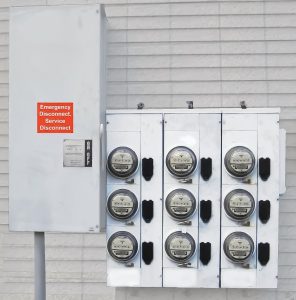How are 2023 NEC emergency disconnect requirements different for one- and two-family dwellings?
Overview
The 2020 edition of the National Electrical Code introduced the requirement for emergency disconnects to be provided in a readily accessible outdoor location for all one- and two-family services. As with most requiremen ts that are newly introduced, they evolve over time to provide clarification. This is precisely what has taken place in the 2023 edition of the NEC. Section 230.85 has been reorganized into subdivisions with titles, and has been supplemented with additional provisions to help clarify the requirements regarding emergency disconnects for one- and two-family dwellings. This will help the electrical professional better understand and apply the provisions of the NEC.
ts that are newly introduced, they evolve over time to provide clarification. This is precisely what has taken place in the 2023 edition of the NEC. Section 230.85 has been reorganized into subdivisions with titles, and has been supplemented with additional provisions to help clarify the requirements regarding emergency disconnects for one- and two-family dwellings. This will help the electrical professional better understand and apply the provisions of the NEC.
Applying the 2023 Code
In the 2020 NEC, the requirements of 230.85 (Emergency Disconnects) were grouped together in a single section. The 2023 NEC expands this section by breaking it up into subdivisions with titles. There is now a subdivision for: (A) – General, (B) – Disconnects, (C) – Replacement, (D) – Identification of Other Isolation Disconnects, and (E) – Marking. These changes were made to follow the styling requirements of the NEC. Section 230.85(C) was added to clarify that when a service is installed new, or simply replaced, it must be brought up to code by complying with the requirements of 230.85. An exception was added, however, that exempts this requirement if only meter sockets, service conductors, service raceways, and/or fittings are replaced. This means that if a storm comes through an area and damages an overhead service, requiring the service mast and meter socket to be replaced, the entire system is not required to be upgraded to include an emergency disconnect. Additionally, Section 230.85(D) requires a plaque to be provided with lettering at least 1/2″ high denoting the location of other emergency disconnects.
What’s New for the 2023 NEC?
2020 NEC
In the 2020 NEC Section 230.85 read as follows:
230.85 Emergency Disconnects.
For one- and two-family dwelling units, all service conductors shall terminate in disconnecting means having a short-circuit current rating equal to or greater than the available fault current, installed in a readily accessible outdoor location. If more than one disconnect is provided, they shall be grouped. Each disconnect shall be one of the following:
(1) Service disconnects marked as follows:
EMERGENCY DISCONNECT,
SERVICE DISCONNECT
(2) Meter disconnects installed per 230.82(3) and marked as follows:
EMERGENCY DISCONNECT,
METER DISCONNECT,
NOT SERVICE EQUIPMENT
(3) Other listed disconnect switches or circuit breakers on the supply side of each service disconnect that are suitable for use as service equipment and marked as follows:
EMERGENCY DISCONNECT,
NOT SERVICE EQUIPMENT
Markings shall comply with 110.21(B).
2023 NEC
In the 2023 NEC Section 220.41 now reads as follows (less the informational note):
230.85 Emergency Disconnects.
For one- and two-family dwelling units, an emergency disconnecting means shall be installed.
(A) General.
(1) Location.
The disconnecting means shall be installed in a readily accessible outdoor location on or within sight of the dwelling unit.
Exception: Where the requirements of 225.41 are met, this section shall not apply.
(2) Rating.
The disconnecting means shall have a short-circuit current rating equal to or greater than the available fault current.
(3) Grouping.
If more than one disconnecting means is provided, they shall be grouped.
(B) Disconnects.
Each disconnect shall be one of the following:
(1) Service disconnect
(2) A meter disconnect integral to the meter mounting equipment not marked as suitable only for use as service equipment installed in accordance with 230.82
(3) Other listed disconnect switch or circuit breaker that is marked suitable for use as service equipment, but not marked as suitable only for use as service equipment, installed on the supply side of each service disconnect
(C) Replacement.
Where service equipment is replaced, all of the requirements of this section shall apply.
Exception: Where only meter sockets, service entrance conductors, or related raceways and fittings are replaced, the requirements of this section shall not apply.
(D) Identification of Other Isolation Disconnects.
Where equipment for isolation of other energy source systems is not located adjacent to the emergency disconnect required by this section, a plaque or directory identifying the location of all equipment for isolation of other energy sources shall be located adjacent to the disconnecting means required by this section.
(E) Marking.
(1) Marking Text.
The disconnecting means shall marked as follows:
(1) Service disconnect
EMERGENCY DISCONNECT, SERVICE DISCONNECT
(2) Meter disconnects installed in accordance with 230.82(3) and marked as follows:
EMERGENCY DISCONNECT, METER DISCONNECT, NOT SERVICE EQUIPMENT
(3) Other listed disconnect switches or circuit breakers on the supply side of each service disconnect that are marked suitable for use as service equipment and marked as follows:
EMERGENCY DISCONNECT, NOT SERVICE EQUIPMENT
(2) Marking Location and Size.
Markings shall comply with 110.21(B) and both of the following:
(1) The marking or labels shall be located on the outside front of the disconnect enclosure with red background and white text.
(2) The letters shall be at least 13 mm (1⁄2 in.) high.
